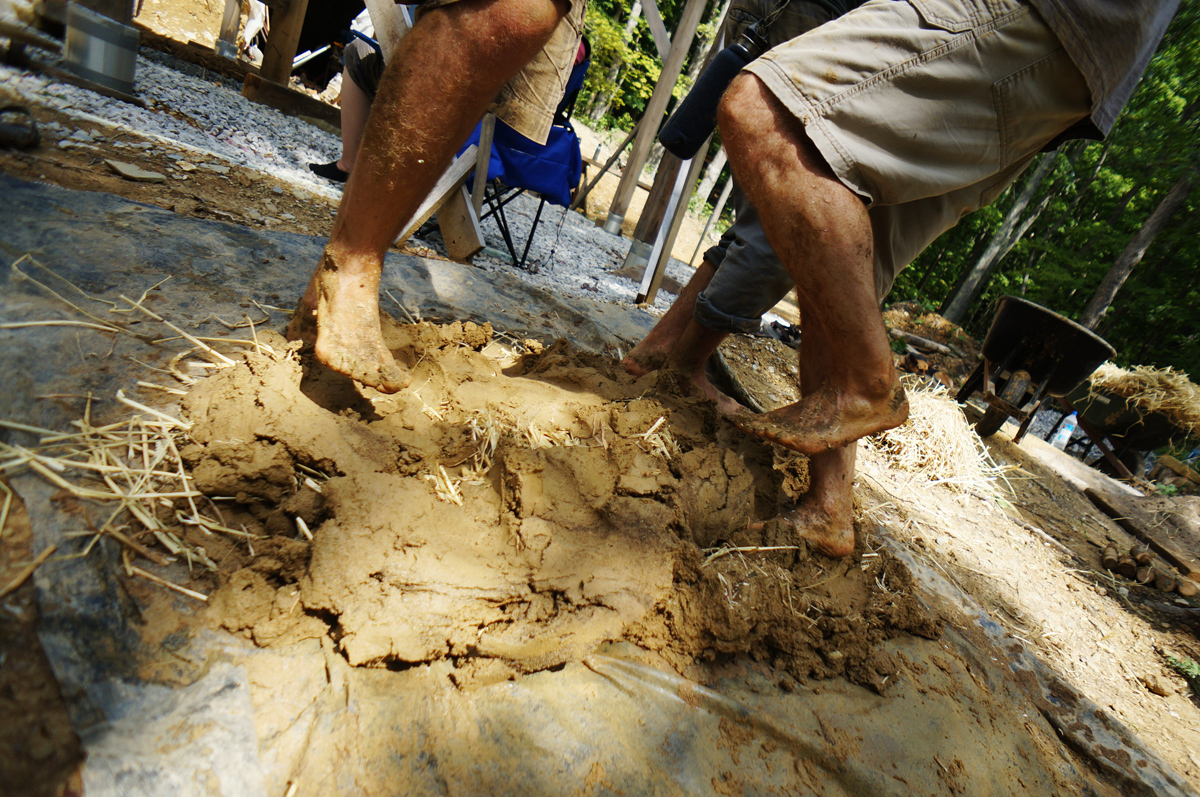In the seven years I’ve run The Year of Mud and written about building with cob, I realize I haven’t written a simple ‘how to mix cob’ post. For many folks, particularly anyone coming across my various cob oven articles online, it may not actually be obvious how you mix cob, whether it’s for an oven, bench, building a house, etc. So, better late than never — here is a handy reference if you want to mix the perfect batch of cob for your project!
Building with Cob: How to Mix Cob
Let’s try to keep this basic and to the point. Cob is the simple combination of sand, clay, straw, and water. The proportions of these ingredients will greatly affect the strength, sculptability, and ease of use of this timeless natural building material. Depending on where you live, and the type of sand and clay you have access to, you may end up altering this “base recipe” for the perfect batch of cob.
2 Parts Sand
The sand you should look for is coarse, or “sharp” as some building suppliers will refer to it. What you’re after is sand that has a rough texture, not smooth and rounded like beach sand. The sand should “grab” the clay and incorporate easily, and to that effect a range of particle sizes is nice, too.
Fill up a wheelbarrow a few inches shy of the top for a manageable amount to mix.
1 Part Clay
Clay will be different depending on where you dig it up. To see if you have a good quality clay, use this test to see if the subsoil you’ve sourced has a good clay content. Don’t confuse silt for clay — it needs to be sticky stuff. You don’t need totally, 100% pure clay here — as long as the subsoil is rich in clay (enough to easily pass the rolling test), you’re good to go.
Slake (soak) the clay in buckets or barrels overnight to let it absorb water and be easier to mix. 2 1/2 to 3 full five gallon buckets of clay is typically what I use per one wheelbarrow of sand.
Some Straw, Not Too Much Nor Too Little
I have never measured straw in any particular fashion. Straw is strictly “to taste”, and can be varied depending on what application you’re using the cob for. Though more often than not, you’ll want a fairly rich addition of straw — enough that each handful of cob has long strands running through it, but not so much that the cob is difficult to work with. Sprinkle it in bit by bit.
And don’t forget — straw should be absolutely dry, and free of mold and decay! Straw from wheat, rice, oats, or other common grains are all acceptable.
Water
If you slake your clay as I mention above, you may want to pour off any excess water before dumping the clay into your pile of sand. It’s much easier to add water than to take away. The cob should never be difficult to mix… it will take a bit of time, probably 10-15 minutes of stomping with some experience, and the clay and sand should incorporate easily. If it’s not, add some water a bit at a time.
Mixing Cob: Step By Step
- Lay out a recycled lumber tarp (at least 6’x8′). Load up your wheelbarrow of sand, and dump it in the middle of the tarp. Use your hands to carve out a small depression in the middle of the sand pile.
- Pour off the water from 3 buckets of clay, and dump the clay into the sand pile. Remove your shoes, and get stompin’.
- Every minute or so, use the edge of the tarp to pull and roll the material to more quickly incorporate the sand and clay. Add water if necessary.
- Once the sand and clay retain its shape as you roll the tarp (forming the classic “burrito”), it’s time to add straw. (If the pile slumps over instead, you’ve added too much water.) Shake up and loosen fresh straw, and sprinkle the top of the pile. Stomp it in, and add more as necessary.
- Once you’re done, roll the tarp one last time and get ready to cob!
My favorite mix of cob is sticky and sculptable, and should form easily into a “loaf” out of the pile. The straw should be evenly dispersed, and relatively abundant in the pile. If the cob feels too sandy, well… add more clay next time. If it’s too sticky, more sand. Too dry? You guessed it… more water. This is not rocket science, and getting your hands (and feet) in the material is the best way of determining if you’ve got the perfect batch of cob.






For the 27″ oven do you have a rough estimate of the amount of clay used ? I did not see this listed in any of the 1,2,3 sessions. Many thanks in advance.
Randy — good question. I don’t have a rough estimate and have not tried to figure it out. You could attempt to do a volume calculation, assuming the clay is about 1/3 the amount of the sand.